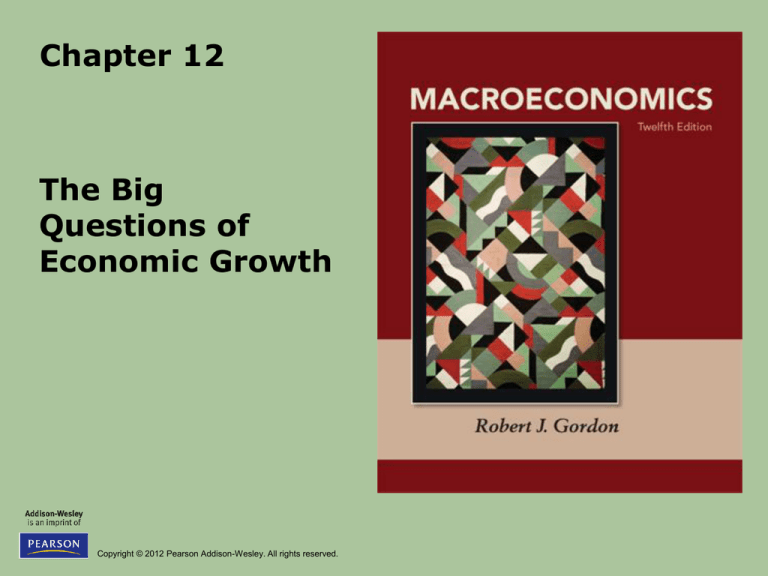
Chapter 12
The Big
Questions of
Economic Growth
Copyright © 2012 Pearson Addison-Wesley. All rights reserved.
The Big Questions of Economic
Growth
• Why are we so rich and they so poor?
– More than half of the world’s population lives on less than
$4,000 per year, below 1/10th of the $48,000 average
level of U.S. per person income
• Why is the same capital so much more productive
in some countries than in others?
– The political environment and investment in
infrastructure are also important extensions to physical
and human capital
• What creates a growth miracle?
– A “growth miracle” is a country that experiences
sustained growth rates of 5% or more for several decades
Copyright © 2012 Pearson Addison-Wesley. All rights reserved.
12-2
Standard of Living vs. Labor
Productivity
• From Ch 11: “Output Per Person,” “Productivity” and “Output Per
Hour” all can be represented by Y/N
– The growth rate of Y/N = y – n
• But labor productivity is defined as output per hour worked
– Introduce H = Total hours of work (growing at rate h)
– Labor productivity = Y/H (growing at y – h)
• The population growth rate (n) does not need to equal the
growth rate of labor input (h)
– Example: The increase in women participation in the labor force caused
h > n in the 1970s and 1980s
• The Standard of Living is real GDP per member of the population,
or “Real Output Per Capita”
– The growth rate of the standard of living = y – n
– The difference in the growth of a country’s standard of living and labor
productivity growth = (y – n) – (y – h) = h – n
Copyright © 2012 Pearson Addison-Wesley. All rights reserved.
12-3
The Significance of n vs. h
• Recall from the previous slide:
growth of (Y/N) – growth of (H/N) = h – n
• European countries lag well behind the U.S. in (Y/N)
– But several EU countries almost at U.S. level of (H/N)
• By 1995, productivity in Western Europe was 91% of the U.S. Level
• It has since dropped back down to 83% of the U.S. level
• Why has the improvement in European labor productivity not
translated into a higher standard of living?
– In Europe: n > h
– So, hours worked has not kept up with the population growth rate
• Europeans take longer vacations than people in the U.S.
• They also retire earlier
• Result: Slow growth in hours worked and lagging standard of living!
Copyright © 2012 Pearson Addison-Wesley. All rights reserved.
12-4
Multifactor Productivity (Solow’s
Residual)
• Recall: Multifactor productivity (MFP) is the amount of
output produced relative to both labor and K inputs
– Let he elasticity of output to capital = b
– Let the elasticity of output to labor = (1 – b)
• The growth rate of MFP = a = y – bk – (1 – b)h
(1)
– Only y, k, h and b need to be known to estimate a
– Robert Solow showed that b can be measured by the share of
capital income
• How is a related to the growth of labor productivity?
– Rewriting (1) yields: a = (y – h) – b(k – h)
– Note: (k – h) = capital deepening, which is the growth of the
K/H ratio
Copyright © 2012 Pearson Addison-Wesley. All rights reserved.
12-5
Real Wage and Productivity
• If labor productivity (Y/H) grows slowly, then the
real wage (W/P) also tends to grow slowly
• Solow showed that:
• In terms of growth rates, this becomes:
• If labor’s share of income is constant, then the real
wage must grow as fast as labor productivity:
(w – p) = (y – h)
Copyright © 2012 Pearson Addison-Wesley. All rights reserved.
12-6
Figure 12-1 Saving, Investment, and Capital
Per Hour in Long-Run Equilibrium for a Poor
Nation
Copyright © 2012 Pearson Addison-Wesley. All rights reserved.
12-7
Figure 12-2 Output per Hour of Rich and Poor
Nations During the Period of Convergence
Copyright © 2012 Pearson Addison-Wesley. All rights reserved.
12-8
The Failure of Convergence
• The Solow model predicts that poor countries will
converge to the same level of output per capita of
rich countries.
– A key empirical prediction is that poorer countries will have
faster rates of growth of labor productivity.
• Problem: While many countries converge
empirically, several chronically poor countries do
not.
• One way to adjust the Solow model to account for
this failure of convergence is to remove the
unrealistic assumption that all nations have the
same production function, saving rate, n and d.
Copyright © 2012 Pearson Addison-Wesley. All rights reserved.
12-9
Figure 12-3 Output per Worker Relative to the
United States in 1960 and the Growth of Output
per Person, 1960–2007
Copyright © 2012 Pearson Addison-Wesley. All rights reserved.
12-10
Table 12-1 Examples of Countries Displaying
Convergence, Anti-Convergence, or Neither
(Levels and Growth Rates in Percent)
Copyright © 2012 Pearson Addison-Wesley. All rights reserved.
12-11
Figure 12-4 The Effect of a Low Saving Rate
or High Rate of Population Growth on Output
per Person
Copyright © 2012 Pearson Addison-Wesley. All rights reserved.
12-12
Technological Change and Human
Capital
• The Solow model assumes unrealistically that the rate of
technological change is the same in every country and the
best available technology is freely available to all countries.
• How can poor countries acquire technology given that most
research takes place in rich countries?
–
–
–
Engineers in poor countries can copy modern products made in
rich countries
Poor countries can purchase imported machinery that embeds
the latest technology
Poor countries can obtain investment by foreign firms.
• But poor countries may also need additional human capital to
use acquired technology.
Copyright © 2012 Pearson Addison-Wesley. All rights reserved.
12-13
Political Capital, Infrastructure,
and Geography
• Recently economists have identified fundamental underlying
sources of growth that help us understand why some
countries “take off” while others do not.
• The legal and political environment
– The free market system requires that entrepreneurs who take
risks have a high probability of making a decent profit
• The legal system must protect private property/patents
• The tax system must be fairly administered so “diversion” is
minimized as it reduces profits.
– Infrastructure is crucial, for instance, in the production of
highways, airports, ports, telephone networks, and electricity
systems.
• Geography cannot be controlled by the government, but also
plays a role.
Copyright © 2012 Pearson Addison-Wesley. All rights reserved.
12-14
Physical Infrastructure and Growth
• Infrastructure is any type of capital not
owned by the individual business firm that
makes the firm’s production more efficient.
– Example: Highways, railroads, airports and ports.
• In some poor countries the value of a business
investment is reduced by poor highways and
airports and other shortages of physical
infrastructure.
Copyright © 2012 Pearson Addison-Wesley. All rights reserved.
12-15
Geography and Growth
• Jeffrey Sachs of CU proposed four hypotheses
regarding the role of geography in growth:
– Technologies developed in temperate areas may not be
applicable to tropical areas.
– Technological development often involves high
development costs and low production costs suitable to
large economics.
• Small economies in tropical regions may be too small to
justify significant investment.
– Poor productivity in rural agriculture in tropical countries
and the prevalence of tropical diseases directly affect
population growth.
– Colonial domination of many tropical countries impeded
the process of economic growth by neglecting the
formation of human capital.
Copyright © 2012 Pearson Addison-Wesley. All rights reserved.
12-16
Uneven U.S. Productivity Growth
Across Eras
• Growth in productivity was substantially faster during 1900-72
than during 1972-95. After 1995, growth picked up again,
only to slow after 2005.
– Early 20th growth fueled by invention of electricity and internal
combustion engine
– Many other inventions also fueled improvements in the standard
of living
• Why did productivity growth slow during 1972-1995?
– The growth of K/H slowed because h increased faster than k as
many teenagers and women entered the labor force
– Higher energy prices led to a large slowdown in energy
dependent industries.
– The highway system was built between 1958-1972 yielding a
one-time improvement in productivity that could not be
duplicated
Copyright © 2012 Pearson Addison-Wesley. All rights reserved.
12-17
Uneven U.S. Productivity Growth
(continued)
• What accounts for the productivity growth revival, 1995-2004?
– Solow’s Paradox: “We can see the computer age everywhere except in
the productivity statistics.”
• The growth revival ended the paradox as use and production of computers fueled growth
– After the “dot.com” bust, companies vigorously cut costs yielding gains in
productivity even as workers were laid off
– Intangible capital growth, like benefits from the Internet, yielded gains
in output even as physical investment in computers fell
• Productivity growth after 2004 and beyond: Highly Uncertain
– Pessimists argue that the computer and Internet-related productivity
gains are a one-time gain
– New consumer items (like the iPad) do not benefit business productivity
– If cost-cutting fueled productivity growth, a renewed economy with more
employment will see the opposite effect
– Long term unemployment from the global economic crisis may result in
deteriorating skills and therefore less human capital
Copyright © 2012 Pearson Addison-Wesley. All rights reserved.
12-18
Figure 12-5 Growth Rate of Labor Productivity
in the United States, 1960–2010
Copyright © 2012 Pearson Addison-Wesley. All rights reserved.
12-19
Figure 12-6 Level of Labor Productivity in
Europe and the United States, 1970-2010
Copyright © 2012 Pearson Addison-Wesley. All rights reserved.
12-20








